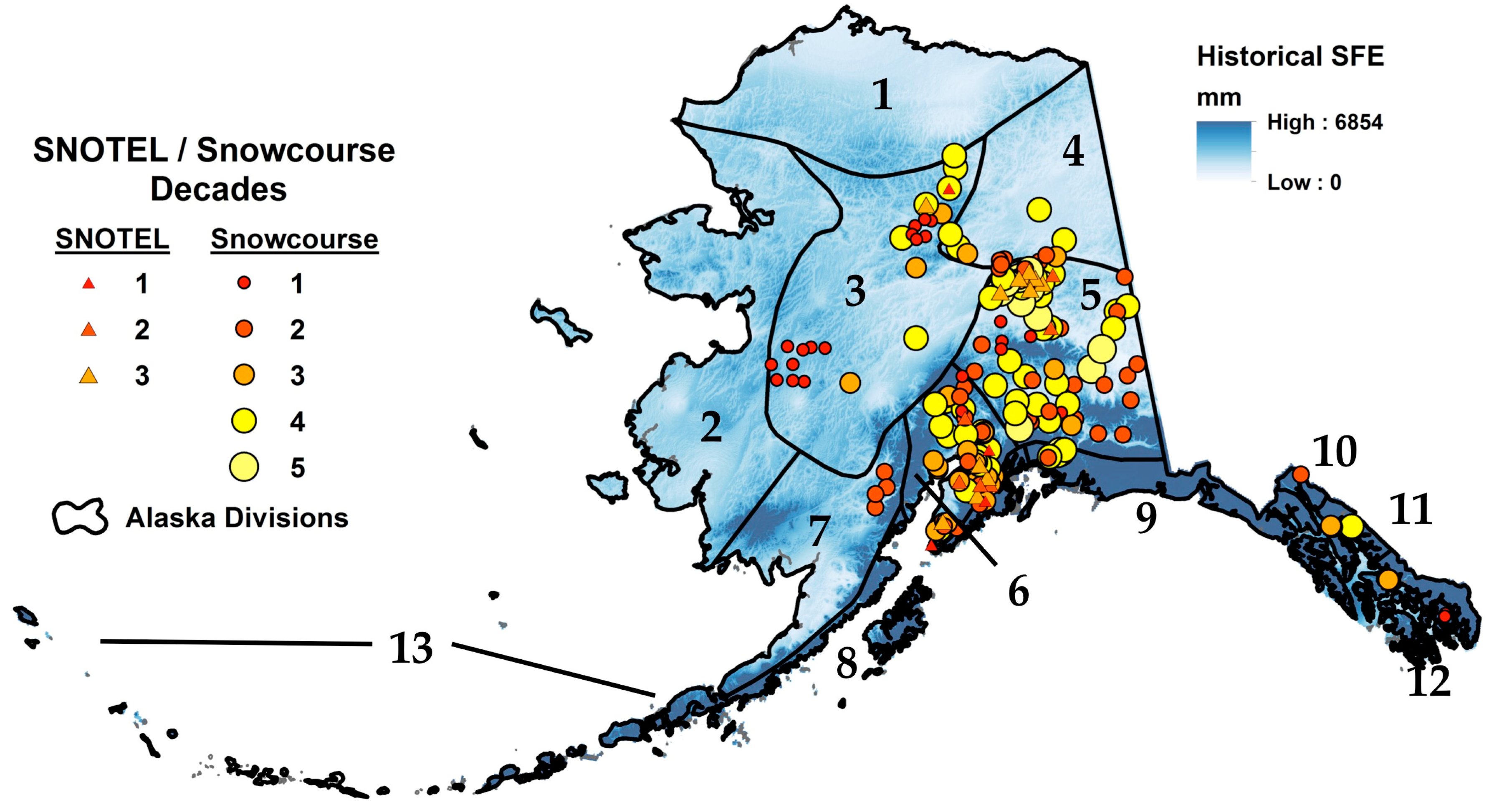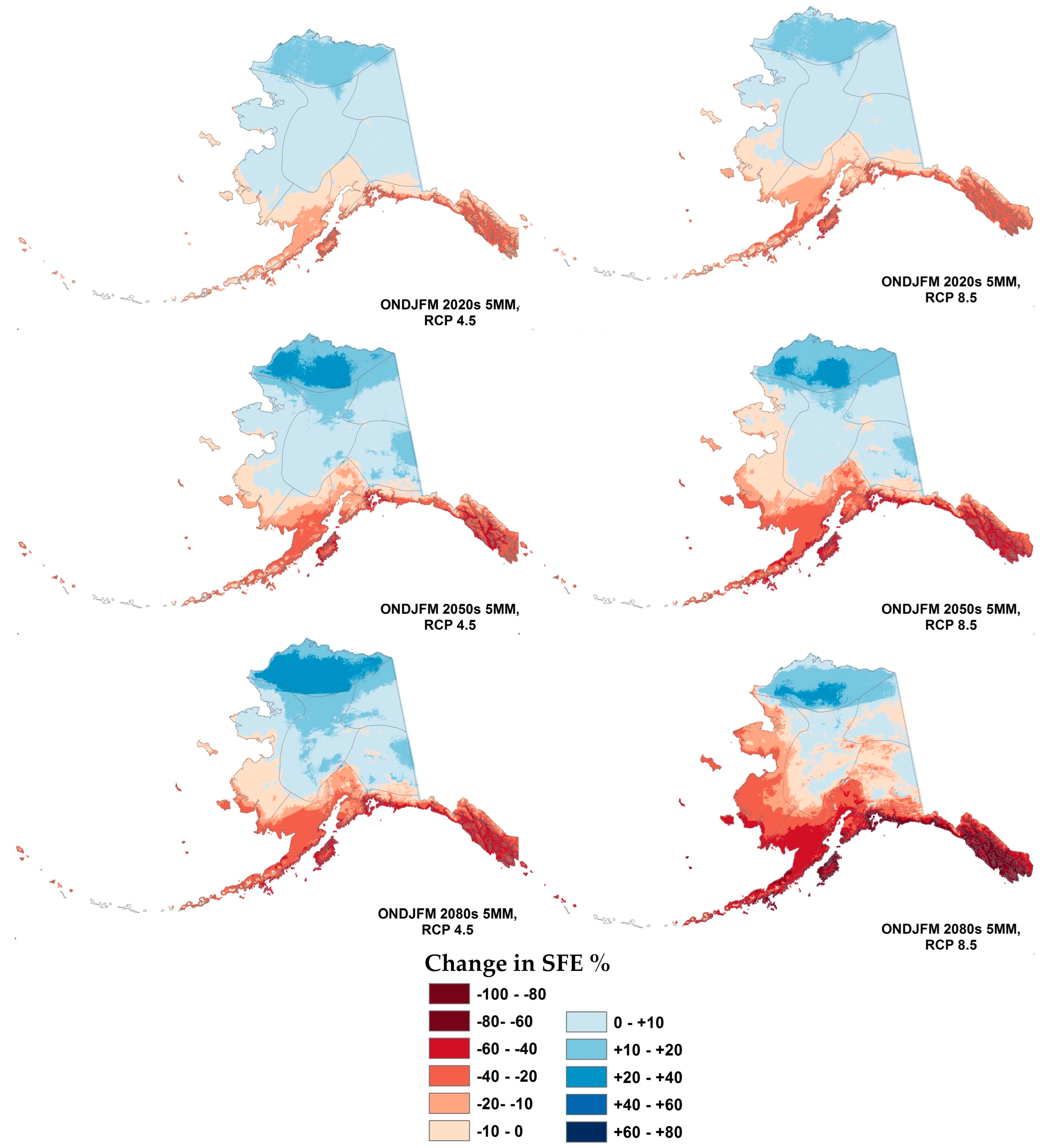1. Introduction
Changes in snow cover, snow depth, and snow water equivalent (SWE) are important mechanisms by which climate change impacts hydrology, ecology, and ecosystem services, especially in regions with seasonal snow cover [
1,
2,
3,
4,
5]. Climate variability [
6,
7] and climate change [
8] have already affected snow cover in the Northern Hemisphere, with snow cover decreasing as air temperatures rise [
1,
9,
10]. Characteristics of snow cover (timing, density, maximum snow water equivalent—SWE) show clear trends associated with increasing temperature across the Arctic [
11]. Phase 5 Coupled Model Intercomparison Project (CMIP5) climate models strongly agree on late-twenty-first century projections of significant increases in winter precipitation and temperature at high latitudes [
12]. Both projected increases in temperature and precipitation affect future snow dynamics in the high latitudes [
13]. Future climate model simulations of snow cover duration (SCD) and maximum SWE indicate that, as climate continues to change, recently observed changes in snow can be expected to continue [
4]. Decreases in snowpack duration and spring snow cover extent are anticipated, but both decreased [
13] and increased [
14] future total snowfall have been projected depending on region and season. Spatial variability in these responses is determined by elevation and regional climate changes: large decreases have been projected at lower latitudes and elevations, with relatively little change in middle latitudes, and increases at the highest latitudes and elevations [
15]. Callaghan et al. [
4] noted that the largest and most rapid decreases in future SCD and SWE occurred over Alaska, northern Scandinavia, and the Pacific Coast region of Russia.
The impacts of these changes on hydrology and ecology, especially the timing and amount of streamflow [
16,
17,
18], availability of snow-related wildlife habitat [
19] and the distribution [
3] and productivity [
20] of vegetation, are of interest to a wide range of ecosystem services stakeholders [
21,
22]. Working with stakeholders in Alaska, we encountered an unmet need for statewide—but fine scale—snowpack projections [
23,
24]. In Alaska, as elsewhere, runoff from snow is important for warm season water availability required for drinking water, hydroelectric power, anadromous fish passage, and recreation. Therefore the relative rates of change and timing of snow-dependent processes are important for assessing consequences of climate change. However, these consequences vary considerably with local-to-regional variations in snowpack, especially where climatic and topographical gradients are steep. The impacts also depend on historical water use and seasonal requirements that vary considerably across Alaska, which has a very large precipitation gradient. For example, interior locations receive less precipitation than Tucson, AZ (294 mm, vs. Fairbanks 275 mm annual average precipitation, National Oceanographic and Atmospheric Administration (NOAA) National Centers for Environmental Information (NCEI) 1980–2010 Normals [
25]), but in southeast Alaska, some locations receive 2500 mm/a more precipitation than the wettest community in the lower 48 US states (Aberdeen, WA, USA, ~3300 mm/a). Projections of hemispheric and continental responses exist, but they are rarely accessible to those interested in finer scale output for climate impacts adaptation or vulnerability assessment. For example, Callaghan et al. [
4] documented historical (1951–2007) decreases in maximum snowdepth and snow cover duration for Alaska and Canada and projected regional responses, including decreased SCD and mixed responses of SWE, but the products are too coarse in scale to be useful for stakeholders. Salzmann et al. [
26] note that studies are “critically lacking with respect to the evaluation of the importance of SWE and SD at the catchment scale”, implying the need for more localized understanding of hydrological responses to snow as well as projected changes in snow dynamics.
To date, no quantitative analysis of statewide downscaled snow projections for Alaska exists. The absence of highly resolved gridded daily historical temperature and precipitation phase products limits validation and bias correction of projected snow responses [
27]. However, snow/rain partitioning approaches e.g., [
28,
29] that use statistical relationships between temperature and precipitation phase allow projections of snow-day fraction at monthly and decadal resolution [
27]. Validation of the existing products for Alaska is also somewhat limited [
24]. Here, we evaluate spatial and temporal variability in late twentieth century (1970–1999) snowfall water equivalent (SFE) against observed SWE and use a multi-model ensemble of downscaled CMIP5 temperature and precipitation fields to estimate future monthly snow-day fraction (PSF), October–March SFE, and the October–March ratio of SFE to precipitation.
2. Materials and Methods
Littell et al. [
24] used future snow-day fraction (PSF) from McAfee et al. [
27] and precipitation to estimate precipitation as snow and potential seasonal accumulation of snowfall water equivalent (SFE, after [
30]) to inform resource managers regarding potential changes in ecosystem services ranging from winter sports to freshwater salmon habitat. However, the utility of snowpack projections for resource planning and vulnerability assessment requires understanding uncertainties and biases introduced by modeling methods; users seek to understand uncertainty and how it informs risk, and bias represents a critical component of uncertainty. To evaluate historical fidelity of snow projections, we obtained gridded historical precipitation [
31] and temperature [
32] from the Scenarios Network for Alaska & Arctic Planning (SNAP). The gridded climate values are 771 m decadally averaged monthly values based on Climatic Research Unit (CRU) TS 3.0 and CRU TS 3.1 [
33] downscaled to the Parameter-elevation Regressions on Independent Slopes Model (PRISM) 1971–2000 climatology [
34]. We calculated PSF as a function of temperature using the same equations (specific to seven Alaska sub-regions and each month) developed by McAfee et al. [
27]. Briefly, the best-fit relationship between decadal average PSF (0 to 1, the fraction of precipitation days in which precipitation falls as snow) and mean temperature is represented by a logistic fit, but the parameters for the fit vary with region and season in Alaska due to complex atmospheric and environmental gradients that influence the probability of precipitation phase given temperature, as shown in a number of previous studies e.g., [
28,
29]. To estimate monthly precipitation as snow for the downscaled decadal data, we multiplied PSF by the decadal total precipitation for each month, resulting in an estimate of maximum SFE.
To validate the assumption that SFE from PSF and precipitation is historically equivalent to SWE, we identified 170 snowcourse and 21 Snow Telemetry (SNOTEL) sites that had April 1 SWE for at least seven years in at least one of the decades for which SFE data were available (
Figure 1). Decadal average SFE from SNAP data based on CRU TS 3.0 and CRU TS 3.1 were summed from October through March and bilinearly interpolated to the coordinates of each station. These values were compared to April 1 cumulative SWE at all snowcourse and SNOTEL sites. We also compared the two gridded SFE datasets to each other at the snowcourse and SNOTEL [
35] site locations. In some cases, snow courses and SNOTEL sites were co-located. In each decade for which data were available (1950–1959 to 1990–1999 for CRU 3.0 [
36] and 1950–1959 to 2000–2009 for CRU 3.1 [
33]), we calculated the pattern correlation across sites using the Spearman method to account for right-skew in the data, root mean square error (RMSE), mean absolute error (MAE), and bias (average error). We also compared changes in April 1 SWE to changes in cumulative October–March SFE over time at each of the locations that had at least three decades worth of data. Correlations of cumulative October–March SFE over time (Pearson) between the two gridded products were made at each location. We considered the assumption that estimated October–March SFE represents April 1 SWE validated if (1) the Spearman rank correlations between SFE and SWE across the network indicate the two processes were significantly related and (2) the mean absolute errors and calculated biases indicated the error associated with the assumption that SFE ≈ SWE was approximately equal to the error associated with the choice of gridded climatology (e.g., CRU TS 3.0 vs. CRU TS 3.1).
To develop future projections of PSF, SFE, and the ratio of October-to-March SFE to precipitation (SFE:P), we first updated the CMIP3 projections of: (1) PSF developed by McAfee et al. [
27] and (2) SFE and SFE:P (after [
24], which refers to the ratio as a snow vulnerability index) using CMIP5 projections. We obtained historical and CMIP5 bias corrected delta method downscaled temperature and precipitation projections from SNAP for five GCMs: NCAR CCSM4, NOAA GFDL-CM3, NASA GISS-E2-R, IPSL-CM5ALR, and MRI-CGCM3. Following Walsh et al. [
37], Walsh et al. [
38] showed these models to perform well over the historical period in the Arctic and Alaska and to represent a range of plausible climate scenarios for the region. We chose to use downscaled projections (771 m decadally averaged monthly values) for RCP 4.5 and RCP 8.5 emissions scenarios. We calculated future PSF as above, and then multiplied it by precipitation to obtain gridded decadal average monthly SFE. We assumed SFE represented an upper estimate of SWE, given no rain-on-snow, melt or redistribution, and used the monthly SFE estimates to calculate SFE:P, the fraction of October-to-March total precipitation potentially stored in spring (April 1) snowpack [
30]. After Elsner et al. [
39] we defined watersheds with SFE:P ≤ 0.1 as rain dominated, 0.1 < SFE:P < 0.4 as transitional, and SFE:P ≥ 0.4 as snow dominated.
To provide a range of future snow scenarios for Alaska, we calculated changes in PSF, SFE, and SFE:P for 2040–2069 and 2070–2099, relative to a historical period of 1970–1999 CRU TS 3.1 for the 5 GCMs under RCP 4.5 and 8.5 emissions scenarios. We summarized these changes by 12-digit Hydrologic Unit Code watersheds (HUC12, approximately 14,000 in Alaska) and report regional differences in the results by Alaska climate divisions (
Figure 1, after Bieniek et al. [
40]).
5. Conclusions
We have shown that SFE developed from gridded PSF and precipitation approximates observed SWE at decadal time scales and the spatial pattern of observed SWE is reasonably captured by historical observations. However, SFE is typically biased low compared to observed SWE, possibly because of our choice of snow season, but also possibly for other reasons including gridded product development. The magnitude bias in any case is similar to the magnitude differences in closely related gridded datasets. Projected changes in October–March PSF, October–March SFE, and SFE:P for Alaska indicate a universal decrease in the length of the snow season and the April 1 SFE:P, but SFE has a more complex response, with large decreases in southern Alaska and at lower elevations and some coastal regions, but modest increases at higher elevations and in the high latitude Arctic because increased precipitation still often falls as snow even in future climates. Historically, most of Alaska was snow dominated, but the area of Alaska considered snow dominated, however, decreases into the future under all scenarios, while transitional and rain-dominated watersheds increase. Gridded products presented here provide a first step toward tools useful for snow-related resource vulnerabilities, but utility for extreme events and interannual variation should be areas targeted for improvement.











